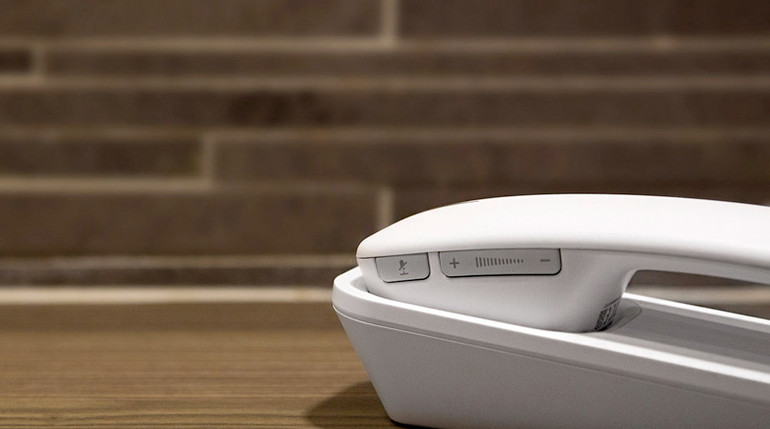A UC handset for the handheld set.
Why would one of the world’s leading producers of headsets start making handsets? It seems like a strange move, but this is precisely what Jabra has gone and done.
The Jabra Handset 450 looks like a normal wireless phone, a nice-looking normal wireless phone. It’s a pleasant size, with a clean, modern design that would look right at home on any office desk. A single USB cord connects the cradle to a computer and powers it, so you won’t be worrying about clutter.
Actually, that single USB cord reveals something more than Jabra’s refined design sense.
That USB cord connects this simple phone with the cutting edge business technology of unified communications (UC).

Building a bridge to unified communications
When Jabra researched the adoption of UC, they found that one in three people who were resistant to adopting UC were resistant because they didn’t want to use a headset. It’s true! For a headset maker like Jabra, this is a very significant number. That’s a lot of people who don’t want to use headsets.
For a business that wants to adopt unified communications, this is also a very significant number. If employees are resistant to how they have to use a technology, they’re much less likely to use it. If you can remove that obstacle by giving them technology they want to use, then they’re more likely to adopt it.
Why don’t they want to use headsets? The reasons must vary from person to person. There’s a certain coldness to headsets, because there isn’t the familiar physical feedback of picking up the phone and holding it to your ear while in conversation. Maybe people simply don’t like the task of putting on a headset, or don’t like the feel of wearing one. Maybe a headset will mess up their hair-do. Maybe they just don’t like the unfamiliar.
There are, when you think about it, many reasons for someone to not want to use a headset initially.
The question is, then, what product will work seamlessly with a UC platform yet remain familiar enough that people will want to adopt it?
The Jabra Handset 450.
But let’s back up a second. Many of you are probably asking: Why would a business want to adopt unified communications in the first place?
What is unified communications?
Unified communications is a business term that describes the combination of voice, video, text, and content sharing technologies. Previously, the technologies for each communication mode were separate: the telephone for voice, paper for text, and so on.
Because all of these technologies now run on computers and over networks and because the technologies are increasingly interoperable, unified communications has become a reality.
Microsoft Skype for Business—to take but one example—is a single platform for every mode of business communication.
But Skype for Business doesn’t only combine the technologies. Because they’re now combined in a single platform, each mode of communication gains the benefits of the others.
The benefits of unified communications
With unified communications, the sum is greater than the parts.
For instance, you can share content with your team no matter where they’re located. Each member can add her or his comments directly to the file. If something’s unclear, a quick conference is a click away. While talking, you can take a poll in the chatbox without disrupting the flow of conversation.
When researchers have looked into unified communications, they have found that companies mention four primary benefits again and again:
- Bringing a dispersed workforce together
- Increasing productivity by increasing collaboration
- Reducing infrastructure costs by combining technologies
- Earning a rapid return-on-investment because of these other benefits
These four reasons are precisely why business owners want their company to adopt UC. If something as relatively minor as a headset versus a handset is preventing adoption, it makes sense to give your employee the option of having a handset.

Jabra Handset 450
So that’s what unified communications is and why it’s beneficial. But what does the Jabra Handset 450 offer that makes it particularly useful for unified communications environments?
As an initial move, Jabra made sure to certify their product. The Handset 450 is Cisco certified, which means it will work with Cisco offerings. The Handset 450 is certified for Microsoft Skype for Business. Both companies have signed off, so you know you’re getting a quality product.
It’s like us at IP Phone Warehouse, how we get manufacturer authorizations to resell their products. The original manufacturer has signed off, so you can trust the product.
But that’s not very specific.
Simple integration
Simple integration into workflow, simple integration with UC: these are the fundamental principles of the Handset 450.
Let’s go back to the look of the thing. It looks like a phone, but you’ll notice when you pick it up that it has very few buttons: only a couple related to volume control. There’s no grid of numbers for you to press.
The phone is built to be used with your computer. When you receive a call over Skype for Business, your Handset 450 rings, and you pick it up—just like any other phone. Similarly, to hang up you, well, hang up. It’s wireless, so you can amble around as you speak. The familiar technology is integrated with the new UC platform. There’s no barrier to entry.
A single USB cord connects phone to computer, and it works. No barrier to entry.
If you sense that a dislike for headset technology is holding back your deployment of unified communications, give the Jabra Handset 450 a try.
And we didn’t even get to the value-added qualities of the Handset 450: the wideband audio, the noise cancellation, the DECT security with additional physical pairing of handset to cradle…

